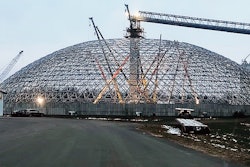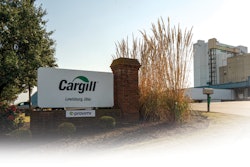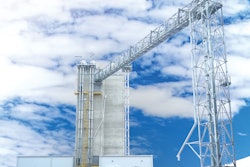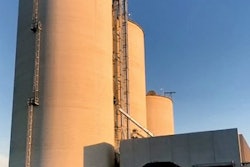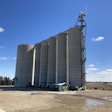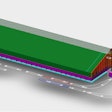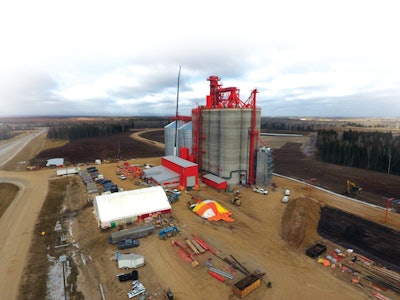
Northern Alberta producers have a new option for shipping grains to market now thatRichardson Pioneerhas finished its advanced inland grain terminal in High Level, AB. Established in 1857, James Richardson & Sons, Ltd., has been a part of Canadian agriculture for over 160 years. Richardson International — of which Richardson Pioneer is a business division — is Canada’s largest agribusiness and a significant player in the food processing sphere.
In 2013, Richardson Pioneer acquired a wood crib facility in High Level as part of the more extensive acquisition of 19 country elevators and 13 crop input centers from another Canadian agriculture company, Viterra.
“When we acquired the facility in High Level, it was only a 6,000-tonne facility,” explains Devon Smith senior director, Zone 1, Richardson Pioneer. “It was built in 1984 and quite small, but it served the community’s needs for the time. This was a market we wanted to stake our claim in, and to do so, we needed to reinvest.”
Richardson Pioneer had always intended to invest in the area, seeing a need in the local market. But when the company acquired a nearby crop input retail location, the need for a modern facility in the area became apparent.
“Richardson Pioneer is fully integrated, and we pride ourselves in that,” says Smith. “We had grown our footprint on the crop input side of the business with the Agland acquisition in La Crete, Alberta, and we wanted to support that with an ability to handle more grain with greater shipping speeds so growers could bring more grain to market locally. The facility we had wasn’t going to do it and upgrading the existing facility wasn’t viable so we were going to have to build new.”
其他公司也感动过left behind grain handling capability. Before the inland grain terminal, producers wanting to grow grain in that region and send it to market had to make a three-hour trek to the nearest grain handler to unload the grain.
Reinvesting
It was in the summer of 2018 that discussions about building a state-of-the-art inland grain terminal in High Level first began. The company started to plan what they wanted to build and scout for land that would meet their needs.
“We were very happy with the piece of property we were able to acquire and appreciate the Town of High Level and the Ag Society’s cooperation during the negotiations. It’s ideally situated on the north edge of town — on the main highway coming from La Crete and Fort Vermilion — which is where a significant amount of acres are situated.”
Once Richardson Pioneer found its site, they were able to quickly come to an agreement with the town for the land in February 2019, however, paperwork, permitting and environmental studies delayed the start of construction until August of that year.
Richardson Pioneer began construction withTodd & Sargent, its builder and engineer based out of Ames, IA. September 2019 was spent preparing the site — removing trees, piling and tunnel work. The crew was working against the clock. Their most significant construction and engineering challenge, the brutal Canadian winter, was approaching fast.
“Being this far north, we had challenges with inclement weather, though we were able to keep everything on track,” says Smith. “A lot of concrete work dragged on later into 2019. When we poured the main workhouse slab, we had subzero temperatures that caused a bit of grief for the engineering group.”
The pour of the concrete workhouse occurred over the course of nine days and was was completed in early spring 2020.
After this, Smith describes a “Lego phase,” which took place over the late spring into the summer. During this time, all of the electrical, handling equipment and support systems were installed.
The facility was energized in October 2020 and was ready for grain the next month.
“On November 23, 2020, we took our first commercial load of grain,” says Smith. “We filled the plant in seven days, then the plant had to stabilize for a month — so we sat until the end of December. Finally, during the second week of January, we shipped our first train out.”
Built for speed
Despite the cold, weather and challenges recruiting enough workers in far northern Alberta, Richardson Pioneer built an incredible facility in an area other ag companies had left behind. Grain trailers arriving at the facility unload onto a 30,000 bushel/hour drag conveyor capable of unloading a 42 tonnes load in just five minutes. This is a big improvement over the old location, where it took 15 to 20 minutes to unload the same size truck. The site has three 30,000-bushels/hour legs, a receiving leg, a flex leg and a shipping leg.
The new facility also has ample grain storage, with two steel bins capable of holding 7,500 tonnes (270,000 bushels) each, along with a sixpack of slipform concrete silos and 16 smaller bins in the workhouse that hold 16,980 tonnes (626,500 bushels) for a total of 31,980 tonnes (1,166,500 bushels.)
Crews worked simultaneously on the main structure and the site’s massive loop track. Richardson Pioneer bought a total of 275-acres of land to fit a 135-car loop track. The facility has reclaim conveyance capable of moving 60,000 bushels/hour to a 100-tonnes upper garner that feeds a 15-tonnes scale. The system can fill a 100-tonnes rail car in just four minutes. The old crib elevator in High Level took 18 minutes to fill a car.
Faster conveying is possible with automation, something the old facility had very little of before Richardson Pioneer took over.
“The automation we have here at High Level isn’t anything over and above what we have with some of our heritage facilities,” says Smith. “But it’s a big upgrade for the staff. We run a LV control system, which is an automated computer system that runs your gates and your distributors and everything else. At the old facility, it was a lot of manual opening gates – even for
the distributors.”
Automated processes were necessary if Richardson Pioneer was going to offer a viable avenue for the surrounding producers to sell their grain. The former facility was still hand sampling trucks, further slowing down the movement of a truck through the site.
“The driveway truck probe really sped up the operation,” explains Smith. “We can have one truck dumping, two other trucks — which have already been probed — waiting, and a fourth truck getting probed.”
In for the long haul
The community of High Level welcomed Richardson Pioneer’s investment in their community. Smith notes it’s because of the company’s involvement with the local community and their commitment to staying in the area.
“A lot of the feedback we’ve received has been extremely positive,” says Smith. “High Level and Mackenzie County is an area with progressive growers and we really appreciate the patronage we’ve received from them. We’re thrilled to reinvest and continue to support their operations in a more a significant way.””
Richardson Pioneer also strives to invest in the communities where it operates. Through the Richardson Foundation, the company gives back to local organizations like fire departments, youth agriculture groups and hockey arenas.
Through this work, Richardson Pioneer will make sure that the local community shares the company’s commitment to staying at High Level, for the long haul. ■

.jpg?auto=format%2Ccompress&crop=faces&fit=crop&h=48&q=70&w=48)




